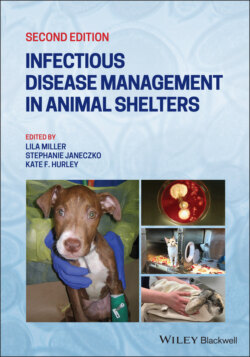Читать книгу Infectious Disease Management in Animal Shelters - Группа авторов - Страница 84
3.2.7 Recording Changes Affecting the Surveillance Program
ОглавлениеChanges that can have an impact on disease frequency occur routinely in shelters. For example, turnover in foster‐care providers or staff, shifting shelter priorities, or changes to the economy of the community can impact the magnitude of disease rates and their interpretation. For example, in one community, the 2008 economic downturn resulted in the surrender of an increased number of animals requiring veterinary care because owners could not afford treatment. If the nature and timing of those changes are not recorded, people forget, and incorrect conclusions may be drawn from the data. One strategy for capturing these changes is a “Log of Events and Protocol Changes” that is updated as changes occur. An example of a log is provided in Table 3.2.
Table 3.2 Log of events and protocol changes for 2015.
| Date | Relevant Events |
|---|---|
| 1‐Jan | Animal control contracts from Sunny and Marlow towns discontinued. Owner surrenders will continue to be accepted. |
| 20‐Feb | A seizure of 60 dogs from Mary Smith is undertaken. The number of dogs exceeds the housing capacity of the shelter. Crates are set up and dogs are housed in staff offices. |
| 25‐Apr | Grant (~$20,000) received to increase Trap Neuter Return (TNR) efforts. |
| 30‐Apr | The shelter eliminated the part‐time veterinarian position due to financial concerns. |
| 9‐Jul | The intake policy changed. Nuisance feral cats managed by providing traps and spay‐neuter services. Animal Control officers trained to vaccinate stray animals before bringing them to the shelter. |
| 10‐Sept | Shelter eliminated two full‐time staff positions due to budget crisis; shelter is understaffed. |
| 23‐Oct | Funding restored, and two staff members rehired. |
| 15–23‐Dec | Mega adoption event. |
